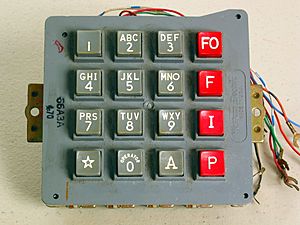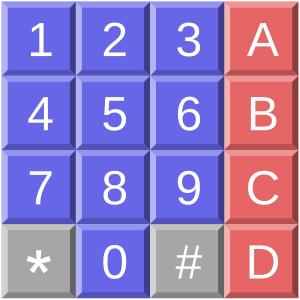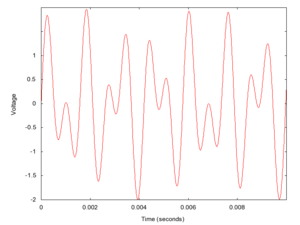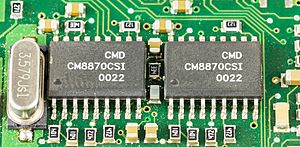Dual-tone multi-frequency signaling facts for kids
Dual-tone multi-frequency signaling (DTMF) is a special way phones and other devices "talk" to each other. It uses different sounds, or tones, to send messages over phone lines. You might know it better as Touch-Tone, which is what Bell System called it when they first introduced it in 1963.
Touch-Tone dialing uses a telephone keypad to make calls. It slowly replaced the old rotary dial phones. Now, it's the main way we dial numbers on phones.
Contents
How Phones Used to Dial
Before DTMF, phones used something called pulse dialing. When you turned the rotary dial on an old phone, it would quickly break the electrical connection. Each break was like a "click" or "pulse." The phone company's equipment would count these pulses to figure out the number you dialed.
This old way of dialing worked well for short distances. But for longer calls, you often needed a phone operator to help connect you. Operators used an earlier system called multi-frequency signaling.
What is Multi-Frequency Signaling?
Multi-frequency signaling (MF) uses a mix of two clear sounds, or tones. Imagine pressing two piano keys at once to make a unique sound. Different MF systems were made for phone companies to talk to each other.
The first MF systems helped operators connect long-distance calls faster. They used a special keypad to send parts of the phone number to the next operator. This made long-distance calls quicker and cheaper.
Building on this success, DTMF was created so regular people could dial numbers without an operator.
How DTMF Works
The DTMF system uses eight different sound frequencies. When you press a button on your phone, it sends two of these frequencies at the same time. This creates a unique sound for each button.
There are 16 possible signals: the numbers 0-9, the letters A, B, C, D, and the symbols # (pound) and * (star).
Because these signals are sounds, they can travel easily through phone lines, amplifiers, and even over radio. This means you don't need operators to connect long-distance calls anymore.
AT&T, the company that owned Bell System, called this "a way for push-button phones to send signals using the voice path." They trademarked the name Touch-Tone. It was first used in public in 1963 when the first push-button telephone came out.
Other phone companies called this feature tone dialing or DTMF.
DTMF Beyond Phone Calls
DTMF signals are also used in other ways. For example, cable television companies used them as special "cue tones." These tones told them when to start and stop showing local commercials during TV breaks. You might have heard these quick tones on cable channels in the past.
Some IP telephony (internet phone calls) systems also use DTMF signals. They can be sent as sounds or as part of the digital signal.
The Phone Keypad
Your phone's DTMF keypad is like a grid. Each row has a low-frequency sound, and each column has a high-frequency sound. When you press a button, it sends one low frequency and one high frequency together.
For example, if you press the 1 key, it sends a 697 Hz low tone and a 1209 Hz high tone. The phone company's equipment then "listens" to these tones to know which button you pressed.
| 1209 Hz | 1336 Hz | 1477 Hz | 1633 Hz | |
|---|---|---|---|---|
| 697 Hz | 1 | 2 | 3 | A |
| 770 Hz | 4 | 5 | 6 | B |
| 852 Hz | 7 | 8 | 9 | C |
| 941 Hz | * | 0 | # | D |
The #, *, A, B, C, and D Keys
Engineers thought that phones might be used to talk to computers or automated systems. So, they added the number sign (#, often called "pound" or "hash") and the asterisk (*) keys. They also added keys for A, B, C, and D.
Most phones don't have the A, B, C, and D keys anymore. But the * and # keys are very common. You use them for special services, like dialing *67 to hide your caller ID.
Some public payphones that take credit cards use these extra codes to send your card information.
The AUTOVON phone system, used by the United States Armed Forces, used the A, B, C, and D signals. These signals helped them make calls with different levels of importance. For example, dialing 93 before a number could make it a priority call.
Today, the A, B, C, and D signals are rarely used in regular phone networks. They are mostly for controlling the network itself.
However, amateur radio operators and two-way radio systems still use the *, #, A, B, C, and D signals. They use them to control their equipment and communicate.
You might also hear DTMF tones at the start or end of some old VHS video tapes. These tones held information about the video, like its format and volume. This helped machines make copies of the tapes correctly.
DTMF tones are also used in some caller ID systems to send the caller's information.
How DTMF Signals are Understood
When DTMF was first made, special filters were used to "hear" and understand the tones. Now, computers use special math (called digital signal processing) to decode them.
Because DTMF signals are sounds, they can sometimes mix with voices or other audio. To make sure they work correctly, there are strict rules for how long the tones should last, how far apart they should be, and how loud they are compared to each other.
Other Phone Tones
Besides DTMF, phone systems have other tones. These tones tell you what's happening with a call or the phone line. For example, a busy signal or a ringing sound are other types of tones. Each country has its own standard for these sounds.
Some early modems, which let computers talk over phone lines, also used frequencies similar to touch-tone sounds.
See also
 In Spanish: Marcación por tonos para niños
In Spanish: Marcación por tonos para niños
- Selective calling
- Special information tone
- Cue tone





